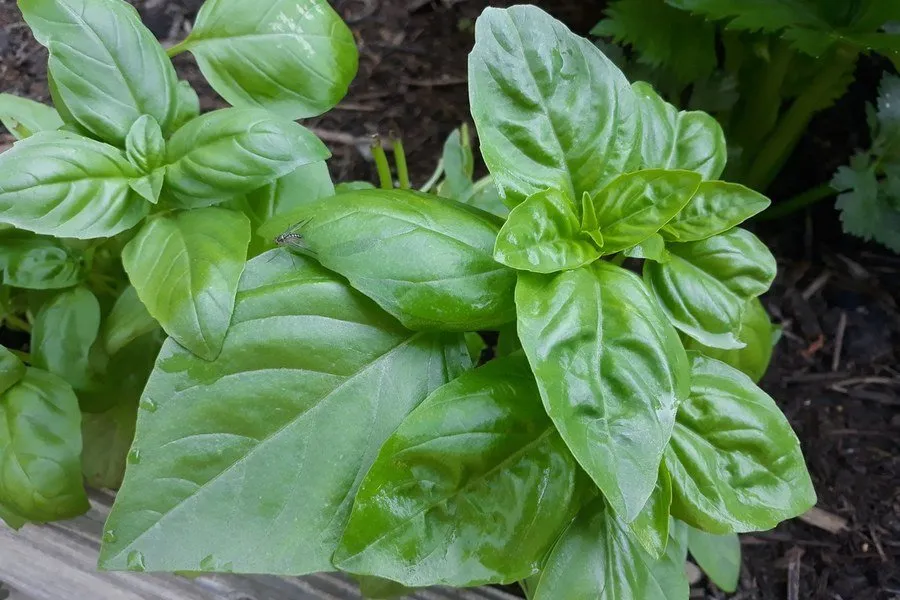Basil, A Summer Favorite

Basil is a favorite herb to grow every summer. Basil tastes great in Italian dishes and is a key ingredient in many other ethnic cuisines. I use it to make homemade pesto sauce for pasta, and I love it in summer sandwiches in place of mayonnaise or mustard. Basil is very easy to grow in Pennsylvania’s warm summer months and will give even the novice gardener much satisfaction to grow and use.
The most common type of basil is sweet basil (Ocimum basilicum). Other types include purple basil (less sweet than common basil), lemon and lime basil (wonderful citrus flavors) and Thai basil (spicy licorice flavor). I grow ‘Genovese’ basil (in Ligurian language, baxaicò or baxeicò) which is one of the most popular cultivars of sweet basil for culinary use, particularly for bruschetta and the traditional Genovese pesto sauce. Additional cultivars of sweet basil include large lettuce leaf varieties like ‘Napoletano’ and ‘Italian Large Leaf’, as well as compact small leaf bush varieties such as ‘Spicy Globe’ and ‘Green Globe’.
Basil is a tender annual that will need to be replanted every season. It requires fertile, well-draining soil. Choose a site with full sun, meaning at least six to eight hours per day. You can start seeds indoors six weeks before the last spring frost in your area, or sow the seeds directly into a prepared garden bed outdoors. As with other edible plants, chose a site with clean soil, away from driveways and busy streets so that exhaust won’t settle on the plants. Basil needs warmth. Transplant or seed after the last frost date for your area and after the soil has warmed to at least 60°F. Basil germinates around 70°F. Do not rush basil. Without heat, this herb won’t grow. Plant seeds about ¼-inch deep and thin to 10 to 12 inches apart. Basil can also be grown in a container with a good fertile potting mix. I get a plentiful harvest with one large (one foot by two feet by 8 inches deep) pot of basil.
Caring for basil throughout the summer is not difficult. Make sure that the soil remains moist. Water the soil and not the leaves. Use a mulch like straw around the basil plants to conserve soil moisture and reduce weeds. After the seedlings have their first six leaves, prune (or pinch) to above the second set. Every time a branch has six to eight leaves, repeat pruning the branches back to their first set of leaves. After six weeks, watch out for early flowering. If flower buds do emerge, just cut or pinch them off. The flavor will be adversely affected if the plant is allowed to flower. Once temperatures hit 80°F, basil will really start leafing out. Continue to pick the leaves regularly to encourage growth throughout the summer. I pick leaves every other day and use them in cooking or preserve them for later use. This keeps the plant growing strong and bushy, providing for a continual harvest through the warm days of fall. With this continual harvest, my container of basil yields enough to make pesto several times with additional leaves for bruschetta and salads. When cold weather is predicted, be sure to harvest all basil. Temperatures below 40°F will discolor leaves, which is why stems of basil picked for use in the kitchen are best held in a glass of water at room temperature instead of in the refrigerator.
Basil is bothered by few pests and diseases. The most serious disease is downy mildew. This is a very recent disease in Pennsylvania. It is characterized by yellowing leaves with a gray downy growth on the undersides. Place the diseased plants in a bag and send them out with your garbage. Downy mildew is an airborne disease which travels great distances in the wind. It is not soil-borne. Cultural practices that minimize leaf wetness and reduce humidity can discourage this fungal growth. Plant basil in an area with abundant sunlight and good air movement. Avoid overhead watering. Unfortunately, all sweet varieties are very susceptible to downy mildew. Thai basil, lemon basil, lime basil, purple, and spicy basils have all been found to be less susceptible.
A good method for preserving basil is freezing. Place whole leaves in a freezer-quality plastic bag, remove the air and freeze. Alternatively, chop leaves into an ice cube tray and add either a little water or olive oil (based on how you will use it later) and freeze until solid. Put the basil ice cubes into a freezer-quality plastic bag, remove as much air as possible, label, and freeze. Pesto can also be frozen using this ice cube method. Another preserving method is drying. Hang stems or place pinched leaves on a cooling rack in a warm, dry, well-ventilated area away from sunlight. You can also dry leaves in a dehydrator. The basil leaves are sufficiently dry when they are crisp. Store whole or crushed leaves in an airtight container in a cool, dark, dry place.
As a gardener and chef, I couldn’t go through a growing season without having my own basil. Of all the herbs to choose to grow, this one won’t let you down.